| SMHRIC |
| July 25, 2018 |
| New York |
On July 4, 2018, the Southern Mongolian Human Rights Information Center (SMHRIC) submitted a report to the Committee on the Elimination of Racial Discrimination (CERD) for consideration of the review of the People's Republic of China during its 96th Session in August. The report highlights the human rights violations occurring in Southern Mongolia, with a particular focus on China's discriminatory policies toward Mongolian way of life, violation of rights of Mongolian herders, arbitrary arrest and extrajudicial detention of political dissidents, and the continuing suppression of the Mongolian language, as well as specific cases of hate crimes and hate speeches by the Chinese against Southern Mongolians.
PDF version of the full submission can be downloaded here.
Table of Contents
1. Introduction
2. Human rights situation in Southern Mongolia
3. China’s discriminatory policies toward Mongolian way of life and violation of land rights
4. Arbitrary arrest and extrajudicial detention of Mongolian herders
5. Degraded treatment and discrimination of Mongolian political prisoners
6. China’s suppression of Mongolian language rights
7. Cases of hate crime and hate speech against the Mongolians by the Chinese
8. Recommendations
Introduction
1. This report submitted by the Southern Mongolian Human Rights Information Center (SMHRIC) on the occasion of the 96th Session of the International Convention on the Elimination of Racial Discrimination (CERD) during which the People’s Republic of China’s compliance with CERD convention is reviewed, draws attention to human rights violations occurring in the country. More specifically, the report will focus on the Chinese authorities’ violation of six million Mongolians’ right to practice their traditional way of life, right to their land, water and other natural resources, right to use their native language, as well as Chinese authorities’ discriminatory, hostile and repressive attitude towards Mongolian tradition and identity in institutionalized and justified forms by Chinese propaganda apparatus and judicial system.
2. The report opens with a brief overview of the history of Southern Mongolia and the general issues in the region, to then cover several central issues: state-sponsored institutionalized form of discrimination, the treatment of Mongolian herders who are protesting for recognition of their rights; the arrest and detainment of political prisoners; degraded treatments of Mongolian political prisoners and their family members, the suppression of the Mongolian language throughout Southern Mongolia, and case examples of hate crime and hate speech by the Chinese toward the Mongolians.
3. Finally, it will present a series of recommendations aimed to facilitate constructive discussion during the CERD 96th Session in Geneva in August 2018.
Human Rights Situation in Southern Mongolia[1]
4. In 1947, two years before the establishment of the People’s Republic of China (PRC), Southern Mongolia declared the ‘Southern Mongolia Autonomous Government’, which was a Southern Mongolian sovereign state that was completely independent and had no official ties to China.
5. Following the establishment of the PRC in 1949, this independent state of Southern Mongolia was annexed to the PRC, and the large part of it is now referred to as the ‘Inner Mongolia Autonomous Region (IMAR)’. Despite the misleading title of “nationality autonomy” which later was to be depoliticized to “ethnic minority autonomy”, all independent and autonomous functions of IMAR were gradually abolished by the Chinese Government. The total territory of IMAR is approximately 1.18 million square kilometers with a current population, according to Chinese statistics, of 24 million. Southern Mongolians make up 1/6th of that population, their population standing at 4 million . (National Bureau of Statistics of the People’s Republic of China on 2010 Census: http://www.stats.gov.cn/tjsj/tjgb/rkpcgb/dfrkpcgb/201202/t20120228_30397.html )
6. However, the total Mongolian territory of historical Southern Mongolia including the IMAR and surrounding Mongolian inhabited areas of Xinjiang Uyghur Autonomous Region, Gansu, Khukhnuur (Qing Hai) Province, Shaanxi, Shanxi, Hebei, Henan, Liaoning, Girin (Jilin), Kharmurun (Heilongjiang) provinces is about 2.5 million square kilometers. The total Mongolian population of Southern Mongolia is about 6 millions which roughly agrees with what the Chinese Government report submitted to the CERD that shows the Mongolian population as 5.81 according to its 2010 census. Certainly this does not include the authorities’ artificially made-up “min zu” or “minority nationalities” such as Bao An, Dong Xiang and Daguur that had always been a branch of Mongolian people. (See China’s submission to CERD: INT_CERD_ADR_CHN_26820_C.doc)
7. Since this annexation, Southern Mongolia has undergone a series of political purging, cultural assimilation, economic marginalisation and environmental destruction at the hands of the Chinese Government. The Mongolians have not only been denied their right to self-determination, the right to their ancestral lands and natural resources but they have constantly been subjected to systematic persecution, ethnic discrimination and have been denied even the most basic human rights of fundamental freedom and human dignity, both individually and collectively.
8. Following his visit to China, the Special Rapporteur for extreme poverty and human rights Philip Alston, issued a report in 2017 in which he stated that despite the Chinese government’s dialogue on the promotion of equality, the ‘reality is that most ethnic minorities in China are exposed to serious human rights issues such as higher poverty rates, ethnic discrimination, forced relocation’.[2] This is certainly the lived reality for Southern Mongolians.
China’s discriminatory policies toward Mongolian way of life and violation of land rights
9. Throughout history, the attitude of agricultural and sedentary Chinese society has always been discriminatory, derogatory and even hostile toward the Mongolian pastoralist way of life and nomadic civilization in general. It has been well-documented that nomadic civilization at large was often characterized by the Chinese as “primitive, backward, archaic, uncivilized”, and the Mongolians and other pastoralist peoples and nations in the north of the Great Wall were stereotypically termed “barbarians” and “northern savages”. (See terms of “Four Barbarians” here: https://en.wikipedia.org/wiki/Four_Barbarians)
10. Since the People’s Republic of China’s takeover of Southern Mongolia in 1949, these deep-rooted discriminatory attitudes toward Mongolian way of life and the Mongolian people as a whole have not only been failed to be corrected, but also been institutionalized through massive propaganda campaigns of romanticizing Chinese way of agricultural and urban lifestyle as a superior and advanced one over the “crude, archaic and backward” Mongolian pastoralist way of life. Waves of state-sponsored “civilizing projects” have been implemented throughout Southern Mongolia to put these institutionalized discriminations into practice. Such projects include large-scale of Chinese immigration to Southern Mongolia, cultivation of Mongolian pasturelands, and deployment of “development corps”. (See “Cultural Encounters on China’s Ethnic Frontiers” by Stevans Harrell, 1994)
11. Among other discriminatory or rather hostile policies adopted by the Chinese Government in recent years toward Mongolian pastoralist way of life are two sets of legislation aiming publicly to eradicate the entire Mongolian pastoralist way of life and the nomadic civilization once for all. These are the policies of “Ecological Migration” (“生态移民” in Chinese) and the “Total Ban over Livestock Grazing” (“全面禁牧” in Chinese). (See details on these policies here: http://www.smhric.org/news_80.htm)
12. Officially adopted and implemented by the Chinese Central Government since 2001, “Ecological Migration” policy was officially instituted to forcibly relocate the entire Mongolian pastoralist population from their ancestral grazing lands to the predominantly Chinese populated agricultural and urban areas in the name of “protecting the grassland eco-system” and “improving the living standard of rural communities”. The justification of this policy is based on China’s highly discriminatory view of Mongolian pastoralist way of life: Mongolian pastoralist way of life is “backward, archaic and unscientific” one that destroyed Southern Mongolian grassland ecosystem. (See details here: https://www.hrichina.org/sites/default/files/PDFs/CRF.4.2006/CRF-2006-4_Ecological.pdf )
13. Another policy adopted for the purpose of putting an end to the Mongolian traditional way life was the aforementioned “Total Ban over Livestock Grazing”. Under this policy, Mongolian herders grazing livestock on their own pastures were considered criminals and subjected to large fines or confiscation of their livestock. These policies achieved their determined goal with the desired outcome: putting to an end to the millennia-old nomadic civilization within the borders of China.
14. According to a statement posted on May 30, 2012 on the official website of the Central People’s Government of the People's Republic of China, the State Council Steering Committee meeting hosted by Chinese Premier Wen Jiabao passed the “Twelfth Five-Year Plan for the Project on Resettling Nomadic People within China”. The announcement marks a major and seemingly final step toward eliminating the remaining population of nomad herders and eradicating the thousands of years old nomadic way of life in China. According to the statement, the Twelfth Five-Year Plan aimed to resettle the remaining nomad population of 246,000 households or 1.157 million nomads by the end of 2015. The socio-economic and political purposes of the plan were stated “to accelerate the development mode shift of animal husbandry and grassland eco-system protection in pastoralist areas, to maintain ethnic harmony and frontier stability, and to lay a firm foundation for building an all around prosperous society”. (See the original report and the Chinese State Council Announcement here: http://www.smhric.org/news_445.htm and http://www.gov.cn/ldhd/2012-05/30/content_2148928.htm )
15. Another earlier statement posted on August 3, 2011 on the Chinese State Council website states that the Chinese Ministry of Finance allocated a special fund of 1.7 billion Yuan to the project of resettling nomadic herders particularly in “Xinjiang (including Xinjiang Development Corps), Inner Mongolia and Tibet”. (See the original document from Chinese State Council website: http://www.gov.cn/gzdt/2011-08/03/content_1919028.htm )
16. With these two-way population transfer project, or de facto “Mongolians out and Chinese in” policies, China had to come up with an updated narrative of development. As such, in 2009, China announced that IMAR became China’s “Energy Base”, providing the majority of their coal and natural gas production. IMAR also produces 95% of the world’s rare earth supplies (The Economist article “Abundant in Inner Mongolia”: https://www.economist.com/node/14587710 ). Chinese extractive industries, including state-run coal, gas and oil companies, as well as thousands of private miners have poured into the region seeking to make their fortune. To account for this mass immigration of industry, the traditional grazing lands owned by Mongolian herders have been redistributed to these companies and cleared to make way for the establishment of new mines.
17. New land-use policies are intended to make way not only for the expanding Chinese extractive industries, but also for Chinese agricultural farming that is massive in scale and intensive in resource use. To make space for these farms and mines, Mongolian herders are forced to move to urban areas. These land-use policies came along with a deliberate policy of overwhelming Mongolian culture and its traditional way of life through an influx of Han Chinese farmers and immigrants. Mongolian herders are no longer allowed to herd livestock on these lands and often their livestock are confiscated in order to force herders to adjust to urban life and the new way of Chinese agrarian society.
18. As a result, Southern Mongolian grassland ecosystem has been subjected to irreversible destructions. Industrial pollution, land degradation and desertification have become uncontrollable throughout the region and large areas are now reduced to industrial wastelands. The very survival of the Mongolians as a distinct people is threatened. Their right to maintain their traditional way of life, and their right to access their land, water and other resources are completely denied. The Mongolians, who maintained their pastoralist way of life for thousands of years, are now forced by the Chinese authorities to give up their traditions and lifestyle to give way to expanding Chinese encroachment. The small number of Mongolians who remain in their ancestral lands struggle with water shortages and heavily pollution of the natural resources due to large scale agricultural and industrial waste.
19. The traditional owners of this land, who rely solely on it for their livelihood and the continuation of their culture, continue to be forcibly displaced from their land, without adequate compensation or proper resettlement. Under the Chinese Land Administration Law of 1998, those whose rural land is expropriated are entitled to compensation and resettlement subsidies however the amount of compensation is often insufficient to maintain an adequate standard of living.[3]
20. This use and destruction of the grasslands by Chinese agriculturalists violates the Regional Ethnic Minority Autonomy Law (1984, amended 2001). According to Article 27, the destruction of grasslands for agricultural purposes is ‘strictly forbidden’ and the rights of use and ownership of forests and grasslands lies with the autonomous agencies of these autonomous regions, therefore should lie with the Inner Mongolians.[4]
Arbitrary Arrest and Extrajudicial Detention of Mongolian Herders
21. Given the deteriorating situation for the Mongolian herders, tensions have escalated between Chinese authorities and Mongolians, as Mongolians began to protest the destruction of their homelands. In 2011, a Mongolian herder, named Mergen, was killed by a Chinese mining truck which sparked widespread, region-wide protest by Mongolian herders and students. Since then, violent clashes have become a common occurrence across rural Inner Mongolia. Over 450 major protests, demonstrations, sit-ins, peaceful interventions, petitions and violent clashes have been reported in Southern Mongolia in the past three years (See here for details: http://www.smhric.org/news_618.htm ).
22. In defense of the interests of Chinese miners and farmers, the Chinese authorities are using excessive force to crackdown on Mongolians herders’ protests. Many herders who defend their rights to access their ancestral lands and maintain their traditional way of life have been assaulted, injured, hospitalised, arrested, detained and some issued prison sentences (See SMHRIC website: www.smhric.org for multiple reports). The Congressional-executive Commission on China (CECC) Annual Report for the past 3 years have documented the numerous cases of peaceful Mongolian protesters being mistreated by the Chinese authorities.[5]
23. Among the cases of thousands of Mongolian herders who have been victimized and persecuted by the Chinese authorities, we would like to bring to your attention the following few of the most prominent cases. They are the cases of: Ms Bao Guniang; Ms Yingge and Ms Manliang; Mr Wenming and the mass trial of 35 Mongolian Herders in Zaruud Banner.
24. Ms Bao Guniang is a Mongolian from Doloot Sum, Zaruud Banner of Inner Mongolia’s Tongliao Municipality, who was taken by the Chinese police on 26 July 2017 for organising a protest about local authorities’ illegal land grab. Ms Guniang was arrested and has since been detained without trial at a detention centre in the neighbouring Horchin, Middle Banner. A month ago, she was tried behind the closed door and sentenced to 3 years in jail with 4 years reprieve. She is still unreachable and her health condition and wellbeing is uncertain.[6]
25. Ms Yingge and Ms Manliang are two Mongolian sisters from Ongniud Banner in Ulaanhad who were arrested on 29 May 2017 by public security personnel. The sisters were detained for organising a 3-day protest against the state-run Zhong Liang Group Pig Farm, which has illegally occupied a large area of grazing land without any consultation of the local herders. The waste deposits from this farm are not treated or processed properly but dumped in the grazing lands, which causes serious pollution to the water resources and grasses . (Radio Free Asia Mandarin Service: https://www.rfa.org/mandarin/yataibaodao/shaoshuminzu/ql1-12042017110143.html )
26. Communications from the local communities show that the sisters were released from prison, but are still under the authorities’ close surveillance and denied the right to protest and right to movement. In response to widespread calls for their release, government officials have stated that their case is a ‘highly sensitive’ that is ‘beyond the jurisdiction of Ongniud Banner’ ( A video interview of local official of Ongniud Banner published by SMHRIC on YouTube: https://www.youtube.com/watch?v=LxCkWUUuWeY ). This implies that the sisters’ imprisonment may be long-term.
27. Mr Wenming is a Mongolian activist from Ganzag Township, who was taken into custody by police at his home in Hohhot City on 12 December 2016. This arrest followed Mr Wenming posting information on the internet exposing the land grabbing by local authorities in the Ganzag Township (Committee to Protect Journalists report: https://cpj.org/data/people/wen-ming/ )
28. As a graduate from the China University of Political Science and Law in Beijing and being a strong advocate of the rule of law, Mr Wenming assisted a number of Mongolian herders online, mainly helping them to file legal complaints and lawsuits against Chinese officials and businesses owners who had illegally appropriated Mongolian herders’ grazing lands.
29. According to the arrest warrant issued to the family members, Mr Wenming was officially arrested on 20 January 2017, over a month after the date he was taken into custody, on a charge of “disturbing social order”. In February 2017, Mr Wenming was sentenced to two years imprisonment under this charge. As with the other cases stated in this report, Mr Wenming’s lawyers were denied the right to visit him in prison and his whereabouts and health conditions are unknown (SMHRIC statement to UN Minority Forum: http://www.smhric.org/news_625.htm ).
30. In the latest development of the IMAR herders’ resistance movement, the People’s Court of the Zaruud Banner carried out a mass trial against 35 Mongolian herders on 14 January 2018. Arrested for protesting the illegal cultivation of their land, the 35 were detained for 6 months without charge prior to this trial. All 35 herders were given prison sentences on charges of ‘disturbing public order and rallying the masses to attack the government offices’.[7] Relatives and eyewitnesses have stated that the “attacking of government offices” is a groundless accusation, and have confirmed that the herders conducted a peaceful rally and therefore demand the release of all detainees.
31. The prison terms handed down to the herders are as follows:
Mr Wu Tiedan, 5 years; Ms Jin Haixia, 4 years; Mr Borjigin Chingbat, 3 years; Mr Ulzeit, 2 years; Mr Shuang Xi, 2 years; Mr Tsetsenbat, 1 year and 6 months; Mr Madu, 1 year; Mr Sarantsogt, 1 year; Mr Buyan, 1 years; the 26 remaining all received 6 months. The whereabouts and health condition of the 35 convicted herders are still unknown.
32. The continued persecution of peaceful protestors is not only a violation of Article 20 of the Universal Declaration of Human Rights (UDHR) and Articles 8 and 9 of the Convention against all forms of Racial Discrimination (CERD), both of which oblige states to protect their citizens freedom of assembly. Further to this, this action is in violation of China’s own constitution which in Article 35 it states: ‘citizens of the People's Republic of China enjoy freedom of speech, of the press, of assembly, of association, of procession and of demonstration’.[8]
33. In the second UPR cycle, Poland, Germany, Norway, Cote D’Ivoire and Australia all made recommendations to China to safeguard and/or strengthen measures to ensure citizens’ right to freedom of expression and assembly. These recommendations were accepted by China (recommendations 186.138,186.155,186.154,186.157 and 186.136). In total, there were 14 recommendations that referenced the protection of freedom of expression within China, made within the last cycle of the UPR. In spite of this, the situation does not seem to have improved.
Degraded Treatment and Discrimination of Mongolian Political Prisoners
34. Chinese authorities within IMAR repress any type of political dissent in the region with a heavy hand, using arbitrary arrests and detention of these dissenters as a tactic to keep control of the region. Those who express their political disdain or speak out about the conditions they suffer under are labeled as ‘national separatists’[9] and criminalized, despite their right to express their political opinion and their rights as an autonomous national minority being protected within the Chinese constitution and the Regional Ethnic Minority Autonomy Law[10] respectively.
35. The degraded and inhumane treatment of political activists in Southern Mongolia has been a flagrant violation of both Chinese laws and international human rights conventions and standards. Worth of mention are two cases of prominent Mongolian political prisoners, Mr Hada and Ms Govruud Huuchinhuu, who have both been persecuted for their political opinion and activities to promote and protect the rights of the Inner Mongolians.
Case of Mr Hada
36. Mr Hada was born in eastern Southern Mongolia’s Horchin Right Wing Middle Banner in 1955. In early 1981, as a college student he joined the Southern Mongolian Student Movement, which was campaigning to preserve Mongolian identity in IMAR under Chinese law and prevent Chinese authorities from carrying out another round of Han Chinese migration to the region. In May 1992, Mr Hada and other Mongolian activists formed the Southern Mongolian Democratic Alliance (SMDA, originally named as the Mongolian Culture Rescue Committee) and appointed Mr Hada as President.The SMDA advocated for the right to self-determination, freedom and democracy of the Mongolian people.[11]
37. On 10 December 1995, Mr Hada was arrested at his home by the Inner Mongolian Public Security Bureau, who took all documents related to the SMDA, including the names and addresses of more than 100 international academic contacts of Mr Hada. Mr Hada’s wife, Xinna, was also taken into custody shortly after this and investigated for "inciting students to cause a disturbance" due to the student protests that occurred after she publicised the arrest of Mr Hada. Xinna was not charged, however, she was detained for 4 months before her release on 12 April 1996 (Human Rights In China report: https://www.hrichina.org/en/content/4601 ).
38. On August 19, 1996, the Hohhot People’s Procuratorate charged Mr Hada with "espionage", "separatism", "stealing secrets for the enemy" and "organizing counter revolutionary forces" for his involvement with the SMDA. On 11 November 1996, after a closed hearing, Mr Hada was convicted on the charges of separatism and espionage and he received a combined sentence of 15 years in prison, with a further 4 years deprivation of political rights. The Inner Mongolia Supreme People’s Court rejected Mr Hada’s appeal.
39. Mr Hada served his full 15 year term with an additional 4 years extrajudicial detention in a ‘black jail’ in suburban Hohhot. He was finally released in December 2014.[12] However, he is still not a free man, as he remains under house arrest in an apartment owned and guarded by the Inner Mongolia Region Public Security Authorities (Radio Free Asia English Service: https://www.rfa.org/english/news/china/security-tightens-around-home-of-ethnic-mongolian-dissident-hada-09222017111641.html ).
Case of Ms Huuchinhuu Govruud
40. Another case we would like to highlight is the case of Ms Huuchinhuu Govruud, a human rights defender, dissident writer and activist.
41. In November 2010, Ms Huuchinhuu was arrested by the Chinese authorities for rallying the Mongolians, via the Internet, to gather and celebrate the release of Mr Hada. Ms Huuchinhuu was detained in a secret location, with no information given to her family, for nearly two years after this arrest. Before her trial, Ms Huuchinhuu was placed under house arrest in one of her relatives’ residences in Tongliao Municipality where she was denied the right to freedom of expression and forbidden to communicate with anyone via the Internet, phone or written letters.[13]
42. On 28 November 2012, Huuchinhuu was tried behind closed doors and pronounced guilty by the Tongliao Municipality People’s Court for “providing state secrets to a foreign organization” and has since been placed under indefinite house arrest, despite this never officially being announced by Chinese authorities.
43. Unfortunately, both Ms Huuchinhuu and her only son, Mr Cheel Borjigin, were both diagnosed with terminal brain cancer within a short time-frame of one another. Mr Borjigin was living and receiving necessary medical treatment in the United States, however, despite these exceptional circumstances Ms Huuchinhuu was denied a passport to travel as she posed a ‘possible threat to the national interest and state security of China’. Her requests to travel to be with her son and to receive much needed medical treatment herself were continuously denied.
44. Mr Borjigin, who was also critical of the Chinese government, was also continuously denied access to the region. As a result of these incredibly strict and unwarranted travel restrictions, both Ms Huuchinhuu and Mr Borjigin, sadly passed away in separate countries without getting to see each other. Ms Huuchinhuu’s surveillance, travel restrictions and virtual house arrest continued up until her death in 2016 (SMHRIC report: http://www.smhric.org/news_599.htm ).
45. The rights of China’s many ethnic and religious minorities are enshrined in a number of international conventions, which China is party to such as the Convention on the Elimination of all forms of Racial Discrimination (CERD), the Universal Declaration of Human Rights (UDHR) along with China’s own constitution. In the 2nd cycle of the UPR, 6 states including the United States of America, made recommendations to China to take measures to protect and guarantee the rights of minorities (recommendations 186.221; 186.222;186.223; 186.224;186.233;186.234). These examples here are only a few of the most serious cases among many. The situation facing individuals who fight for the enjoyment and protection of those rights, which they are entitled to, is severe especially for those from minorities.
China’s Suppression of Mongolian Language Rights
46. Less than 20% of IMAR’s estimated 25 million residents are ethnic Mongolians. About 80% are Han Chinese.[1] Article 4 of the Chinese Constitution explicitly provides: “All nationalities have the freedom to use and develop their own spoken and written languages and to preserve or reform their own folkways and customs.”[2] However, the Mongolian language being the official language in IMAR, remains a mere formality.[3]
47. Several UN treaty bodies have expressed their concerns over the language right of minorities in China, including the Committee on Economic, Social and Cultural Rights,[4] Committee on the Elimination of Racial Discrimination[5] and the Committee on the Rights of the Child.[6] In the 2013 Report of the Human Rights Council, China conceded that “[m]inority ethnic groups enjoy extensive human rights. Their […] right to use and develop their spoken and written languages are respected and guaranteed.”[7]
48. The decline of the Mongolian language finds its support in empirical research. Reports dating back to the 2000s already indicated a gradual language shift from Mongolian to Chinese, starting from the urban and upwardly-mobile Mongols due to the Chinese-language domination socially, economically and politically.[8] It was observed that Mongolian youth began using less Mongolian and more Chinese compared to their parents.[9] Importantly, a recent study has found a sharp decline in the number of Mongolian-monolingual and an increasing pressure to abandon Mongolian among bilingual households (“among children raised in bilingual households, 16.5% failed to acquire Mongolian”).[10]
49. Despite a positive obligation of the Chinese government to ensure the use of their mother tongue by ethnic Mongols,[11] it is noted that the policies of the Chinese authorities are conducive to the phenomenon, including its population-transfer programme in which mainly Mongol herders are removed from arid regions of Southern Mongolia, who are then resettled on the outskirts of predominantly Han cities where only Chinese-language schools are accessible.[12] Such assimilation has two major implications. First, the simultaneous transfer of Chinese population into the Mongol lands raises the Chinese majority, thereby critically linking the Chinese language to opportunities in employment. In some cases, Chinese employers, including government agencies, would explicitly state that “no candidate educated in Mongolian is considered”.[13]
50. Second, as a result of the population transfer, many Mongolian elementary schools have been eliminated and most Mongolian middle schools at the Sum administrative level (equivalent to districts) have been merged into Han schools, where Mongolian students must learn in Mandarin,[14] known as the “quick urbanization” programs.[15] Thus, for 210,000 Mongolian inhabitants of the capital city Hohhot, there are only two Mongolian elementary schools, compared to less than 3,000 enrolled schoolchildren (i.e. less than 1% of the total Mongolian population in the city).[16] Throughout IMAR, the number of enrollees at Mongolian elementary schools had dropped from 110,000 in 1980 to 19,000 in 2009 (a 82.27% drop in 29 years).[17]
51. Suppression and discrimination of the Mongol language are demonstrable by a number of recent incidents. On 5 December 2016, Mongolian parents protested over the restricted use of Mongolian targeted in two kindergartens in Ulaanhad city (“Chifeng” or 赤峰市in Chinese), namely the Ulaanhad’s 6.1 Kindergarten and Xincheng Mongolian Kindergarten. Additionally, after the appointment of two Han Chinese principals to these kindergartens the existing Mongolian teachers were not allowed to speak Mongolian to each other or to plan Mongolian-language lessons.[18] In January 2018, the last school teaching in Mongolian language in the Bayangol Prefecture of China (a former autonomous Mongol province that now forms part of the “Xinjiang Uyghur Autonomous Region” or 巴音郭楞蒙古族自治州 in Chinese), the Bayangol No. 3 High School, was banned from teaching in Mongolian.[19]
52. Lastly, various other policies contributing to the decline of Mongolian include the targeting of Mongolian language websites,[20] the denial of Mongolia as a language for work and services within the IMAR administrative units[21] and the lack of computerization of the traditional Mongolian written language.[22] For instance, translators are no longer provided in government offices and public service agencies, and government documents are distributed only in Chinese. Furthermore, Mongolian names must meet the format of Chinese names and their family names are not allowed on any government-issued identity documents. To date, the Mongolian writing cannot be searched on the Internet and cannot be freely transmitted in any other ways other than converting it into images.
Cases of Hate Crime and Hate Speech against the Mongolians by the Chinese
Case of Mr. Mergen
53. On May 10, 2011, Mr. Mergen, then 35 years old Mongolian herder in Southern Mongolia’s Shiliingol region, was killed by a Chinese coal-hauling truck while he was defending his grazing land from the Chinese mining company. Around midnight, two Chinese coal-hauling truck drivers named Lu Xiangdong and Li Lindong charged on Mr. Mergen and his fellow Mongolian herders on their grassland land, shouting slogans of “a smelly Mongolian’s life worth no more than 40,000 yuan”. The two Chinese truck drivers brutally killed Mr.Mergen by hitting him with the truck and dragging his body for 150 meters before stopping. This hate crime immediately sparked a large-scale region-wide protests by Mongolian herders and students across Southern Mongolia. Chinese authorities mobilized paramilitary forces and riot police to crackdown on the widespread protests and characterized the typical hate crime as a “traffic accident”. (See the details of the case here: http://www.smhric.org/news_376.htm )
Case of Ms. Zhou Zheng
54. On August 29, 2014, Ms. Zhou Zheng, a Chinese railroad employee in Southern Mongolia, posted a message on the Chinese web chat social media Wei Xin stating that “Yes, I hate pure Mongolians. They don’t understand human language, because they are all animals. This breed should be destroyed by humanity,” followed by an icon of a little girl holding a gun and saying “go to hell”. The case was simply settled within the railroad company by terminating Zhou Zheng’s employment according to a document issued by the IMAR railroad authorities. The Chinese authorities remained unresponsive to the calls from the Mongolians to take a legal action against the perpetrator of the hate speech. (See the details of the case here: http://www.smhric.org/news_539.htm )
Recommendations
55. Given the above mentioned human rights violations, systematic and institutionalized discrimination and hostile attitudes towards the Mongolian traditional way of life, the Southern Mongolian Human Rights Information Center (SMHRIC) urges the government of the People’s Republic of China to consider the following recommendations in its obligation to comply with the articles of the International Convention on the Elimination of All Forms of Racial Discrimination and other relevant United States human rights conventions as well as its own constitutions and Ethnic Minority Autonomous Law:
56. To ensure the immediate halt of the continuing implementation of discriminatory and hostile polices of “Ecological Migration”, “Total Ban Over Livestock Grazing” and other measures that are adopted to flagrantly eradicate Mongolian traditional pastoralist way of life;
57. To guarantee the indigenous Mongolian herders’ right to their ancestral land, water and other natural resources, right to practice their traditional way of life, right to mobility within their ancestral territory, and right to remain within the communities where they have invested emotionally and financially for centuries;
58. To put to an immediate end to the Chinese authorities’ massive propaganda campaign to justify their destruction of nomadic civilization and Southern Mongolian natural environment based on deep-seated discrimination that characterizes Mongolian pastoralism as “backward, archaic, unscientific and uncivilized” way of life and advertises Chinese way of life as “advanced, civilized and scientific” one;
59. To withdraw all types of extractive industries, tourist companies and power plants that not only occupy and appropriate large tracts of Mongolian grazing lands, but also devastate the ecosystem, deplete the underground water and pollute the air and water;
60. To immediately release all Mongolian herders who have been arbitrarily arrested, detained, and imprisoned for defending their grazing land from illegal appropriation by either extractive industries or local government and demanding their legal rights to maintain their way of life and to access their land, water and other resources;
61. To free all political prisoners who demanded basic human rights and fundamental freedoms in accordance with international human rights standards and the Chinese laws and regulation, and to restore the freedom of their family members who have been subjected to constant harassment and frequent intimidation;
62. To allow the Southern Mongolians to use their native language in all aspects of their social life including schooling, employment, literature, private, public and political life as Mongolian language is recognized by the Chinese constitution and Ethnic Minority Autonomy Law as the official language within the “Inner Mongolia Autonomous Region”;
63. To ensure the pursuant of legal responsibility against any hate crimes and hate speeches by Chinese individuals, private or public entities and government bodies against Mongolian language, customs, tradition, way of life and identity.
[1] United Kingdom: Home Office, Country of Origin Information Report - China, 12 October 2012, p. 124.
[2] Constitution of the People’s Republic of China, article 4.
[3] Southern Mongolian Human Rights Centre (SMHRC), Report on Human Rights of Southern Mongolia, 5 January 2018, p. 18.
[4] See Committee on Economic, Social and Cultural Rights, Concluding observations on the second periodic report of China, E/C.12/CHN/CO/2, 13 June 2014, para. 36: “The Committee is concerned that ethnic minorities continue to face severe restrictions in the realization of their right to take part in cultural life, including the right to use and teach minority languages […].”
[5] Concluding Observations of the Committee on the Elimination of Racial Discrimination Committee on the Elimination of Racial Discrimination on China, CERD/C/CHN/CO/10-13, 15 September 2009, p. 22: “The Committee has taken note of the policy of bilingual education for ethnic minorities of the State party […]. It is however concerned at reports that in practice Mandarin is the sole language of instruction in many schools in the autonomous minority provinces, especially at secondary and higher levels of education.”
[6] See Committee on the Rights of the Child, Concluding observations on the combined third and fourth periodic reports of China, CRC/C/CHN/CO/3-4, 29 October 2013, p. 17, mentioning “[t]he lack of measures to promote the use and learning of mother-tongue and minority languages in the context of the bilingual education policy”.
[7] Human Rights Council, Report of the Working Group on the Universal Periodic Review (China), 4 December 2013, A/HRC/25/5.
[8] Uradyn Bulag, “Mongolian Ethnicity and Linguistic Anxiety in China” (2003) 105(4) American Anthropologist 753, p. 754, speaking of the process of losing Mongolian language since the 1990s, referring to Dongsheng City in the Ordos area.
[9] Lisa Lim and Umberto Ansaldo, Languages in Contact (Cambridge University Press, 2016.
[10] Sarala Puthuval, "Stages of language shift in twentieth-century Inner Mongolia, China" (2017) 2 Proceeings of the Linguistic Society of America 28:1-14, p. 9.
[11] See for example, Convention on the Rights of the Child, articles 29(c) and 30; International Covenant on Civil and Political Rights, article 27.
[12] Minority Rights Group International, World Directory of Minorities and Indigenous Peoples - China : Mongols, November 2017.
[13] Southern Mongolian Human Rights Centre (SMHRC), Report on Human Rights of Southern Mongolia, 5 January 2018, p. 18.
[14] Ibid.
[15] Southern Mongolian Human Rights Centre (SMHRC), Report on Human Rights of Southern Mongolia, 5 January 2018, p. 18.
[16] Southern Mongolian Human Rights Centre (SMHRC), Report on Human Rights of Southern Mongolia, 5 January 2018, p. 17.
[17] Ibid.
[18] Radio Free Asia, Parents protest curbs on Mongolian language teaching in Chinese schools, 5 December 2016; Southern Mongolian Human Rights Centre (SMHRC), Report on Human Rights of Southern Mongolia, 5 January 2018, p. 18.
[19] In an official document entitled “Notice Regarding the Issuance of the ‘Autonomous Region’s Proposal on Bilingual Education Curriculum Deployment at Compulsory Education Level’” [xin jiao ji (2017) No. 10] issued by the Xinjiang Uyghur Autonomous Region Education Department, starting 1 September 2017, “all courses offered in elementary and middle/high schools must use the national common language and written system as the language of instruction, and additionally offer the ethnic language as a course.” See Southern Mongolian Human Rights Centre (SMHRC), Report on Human Rights of Southern Mongolia, 5 January 2018, p. 18.
[20] For instance, in 2005 the Chinese authorities shut down two popular Mongolian-language websites allegedly carrying “separatist content”. See Minority Rights Group International, World Directory of Minorities and Indigenous Peoples - China : Mongols, November 2017.
[21]. See Southern Mongolian Human Rights Centre (SMHRC), Report on Human Rights of Southern Mongolia, 5 January 2018, p. 19.
[22] Ibid.
[1] Disclaimer: It is important to note here that the name used for the region in question is frequently contested. It is referred to by China, and therefore generally accepted by the international community, as ‘Inner Mongolia’. However, Mongolians from this region refer to their homeland as ‘Southern Mongolia’. The term ‘Southern Mongolia’ covers a more expansive region, incorporating that of the “Inner Mongolia Autonomous Region”, to include the surrounding regions where Mongolians have inhabited for centuries. The ‘Southern’ is in reference to the area’s location to the Gobi desert.
[2] UN Human Rights Council, Report of the Special Rapporteur on Extreme Poverty and Human Rights on His Mission to China, Philip Alston, A/HRC/35/26/Add.2, 28 March 17, para.44.
[3] ibid, para. 50
[4] Regional Ethnic Minority Autonomy Law of the People’s Republic of China (1984) English Translation, provided by the Congressional-Executive Commission on China, 1984, available: https://www.cecc.gov/resources/legal-provisions/regional-ethnic-autonomy-law-of-the-peoples-republic-of-china-amended
[5] CECC 2017 Annual Report, 5 October 17, 148-49; CECC, 2016 Annual Report, 6 October 16, 143–44; CECC, 2015 Annual Report, 8 October 15, 138–39.
[6] Southern Mongolia Human Rights Information Centre (SMHRIC), Report on Human Rights, 8 January 2018, p.
[7] ‘35 Mongolian herders tried, handed down long sentences’ Southern Mongolia Human Rights Information Centre, 24 January 2018 [available via: http://www.smhric.org/news_629.htm]
[8] Constitution of the People’s Republic of China, Amended version 2004, Chapter 2: Article 35, accessible here: http://www.hkhrm.org.hk/english/law/const03.html
[9] ‘Taken away by police, herders accused of ‘national separatism’ Southern Mongolia Human Rights Information Centre, 26 January 2016 [available via: http://www.smhric.org/news_591.htm]
[10] Preamble, para. 2 of Regional Ethnic Minority Autonomy Law of the PRC, available: https://www.cecc.gov/resources/legal-provisions/regional-ethnic-autonomy-law-of-the-peoples-republic-of-china-amended
[11] Southern Mongolia Human Rights Centre, Report on Human Rights, 8 January 2018, p.
[12] AsiaNews.it [online], Mongolian activist released after nearly 20 years, 20 December 2014.
[13] Southern Mongolia Human Rights Information Centre, Southern Mongolian human rights defender, dissident writer and activist, Huuchinhuu, died, 25 October 2016.
Click here for PDF version of the full submission

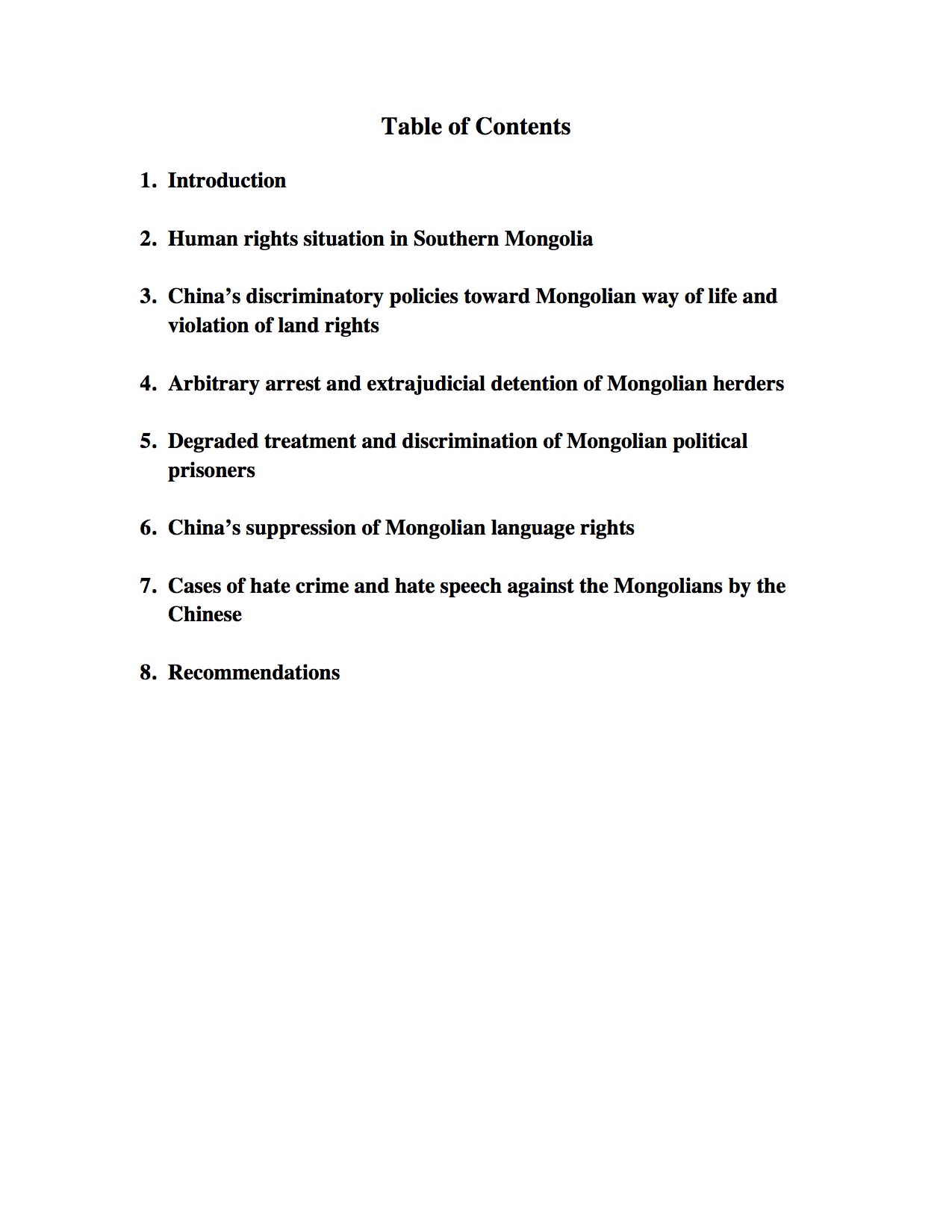
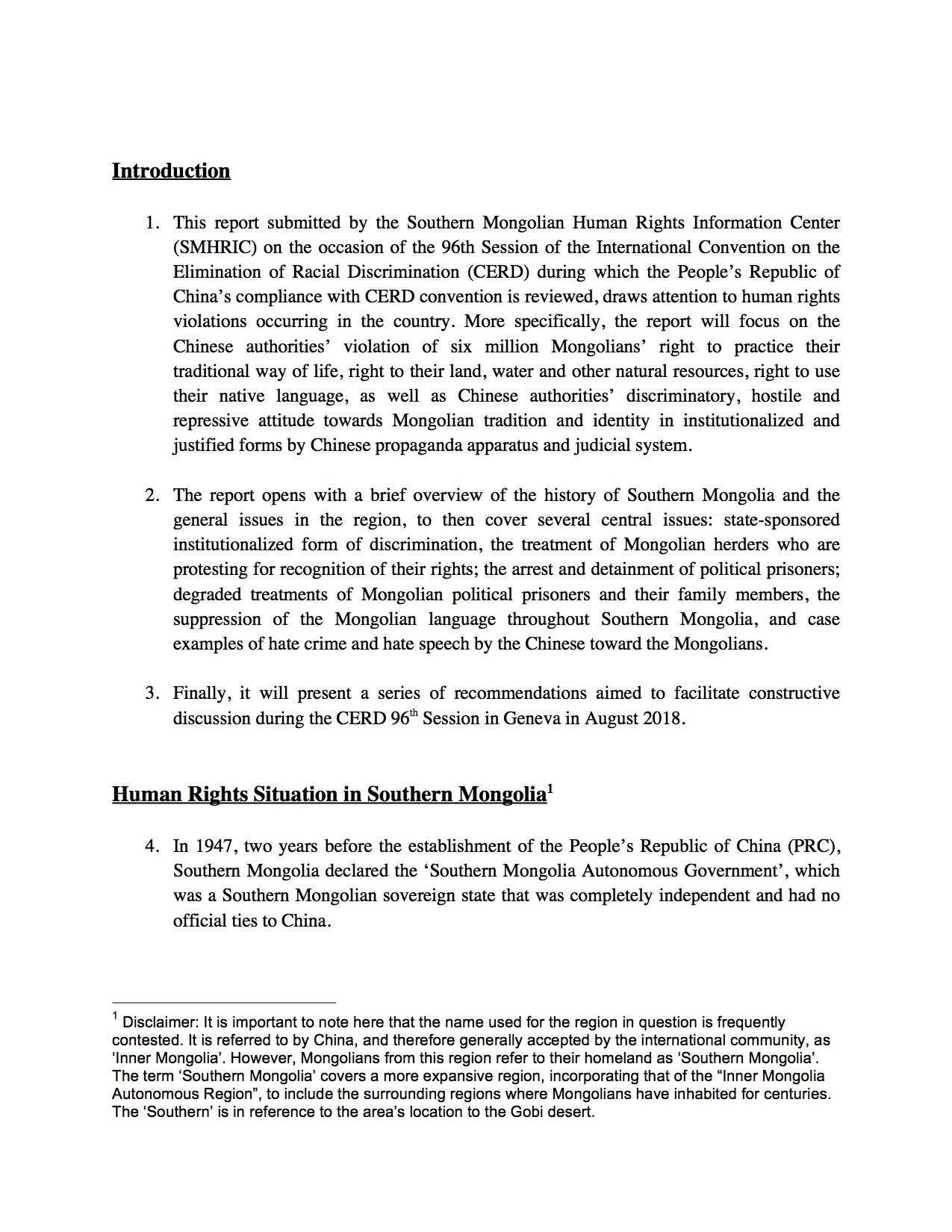
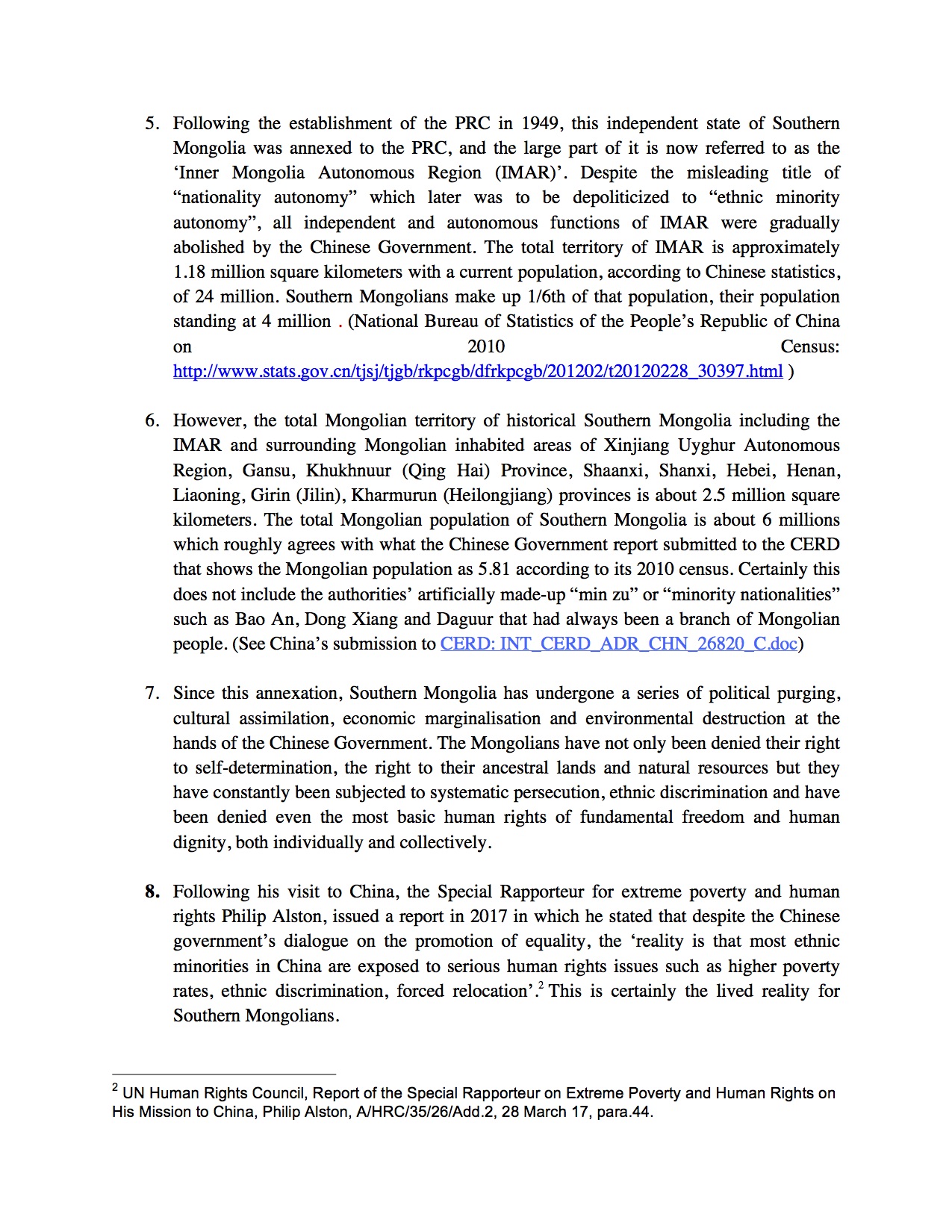
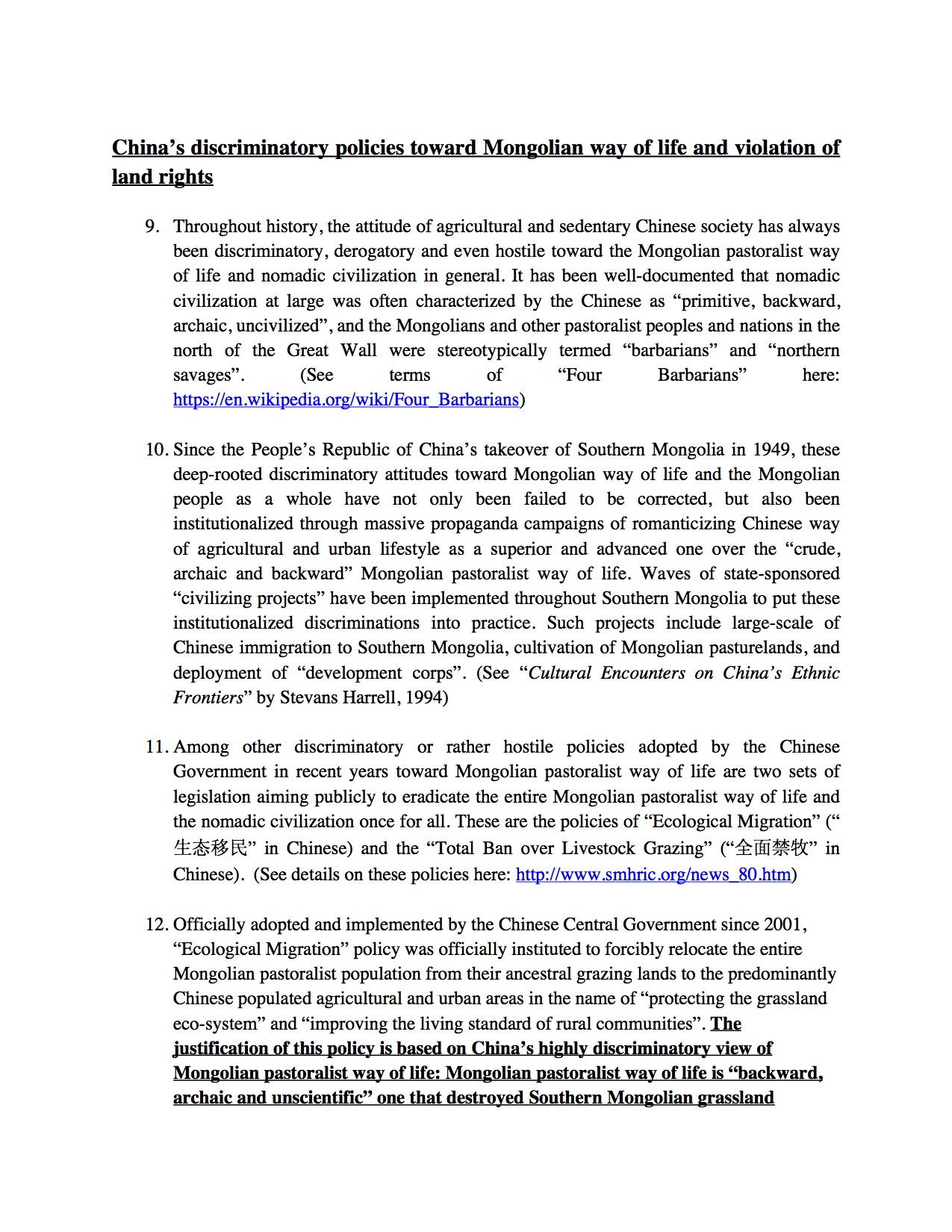
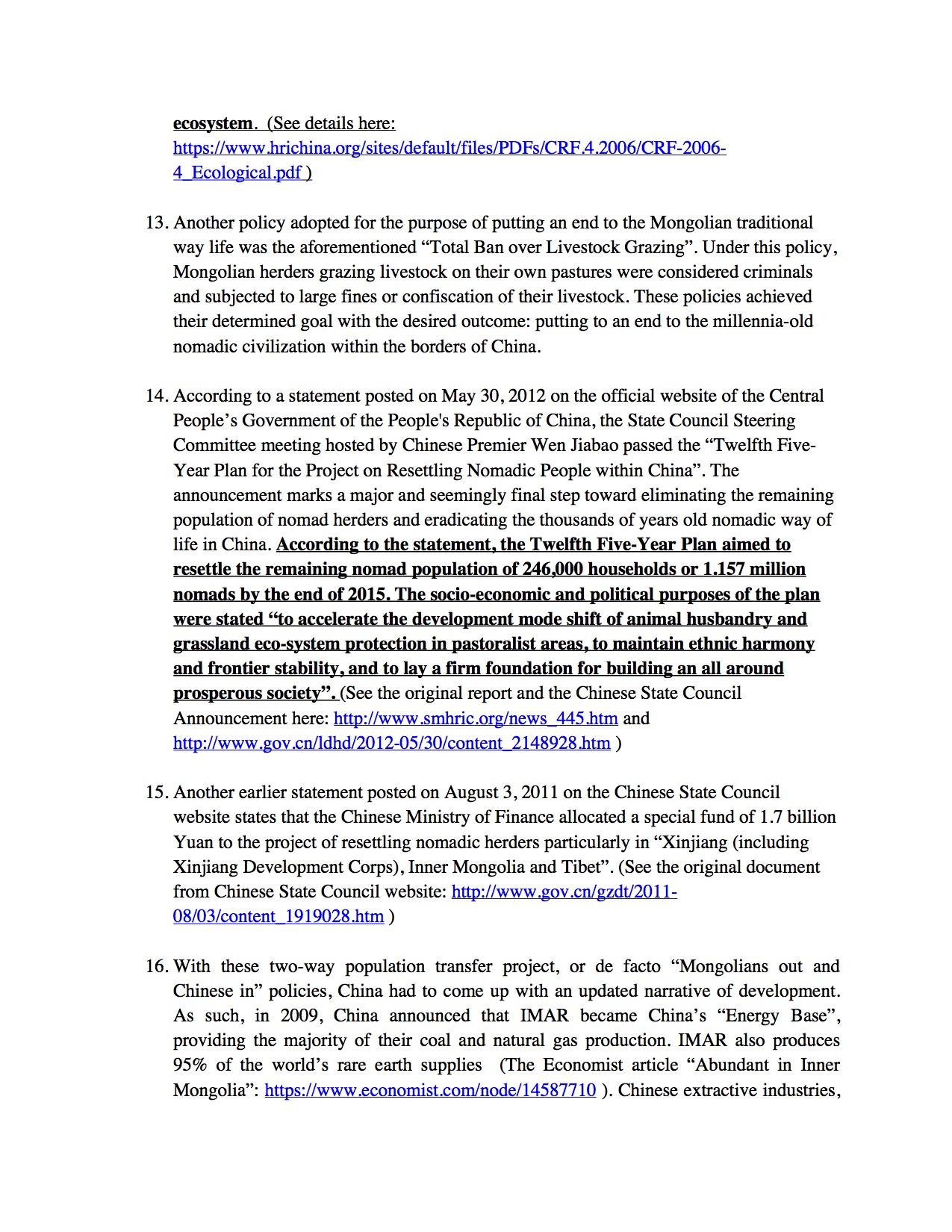
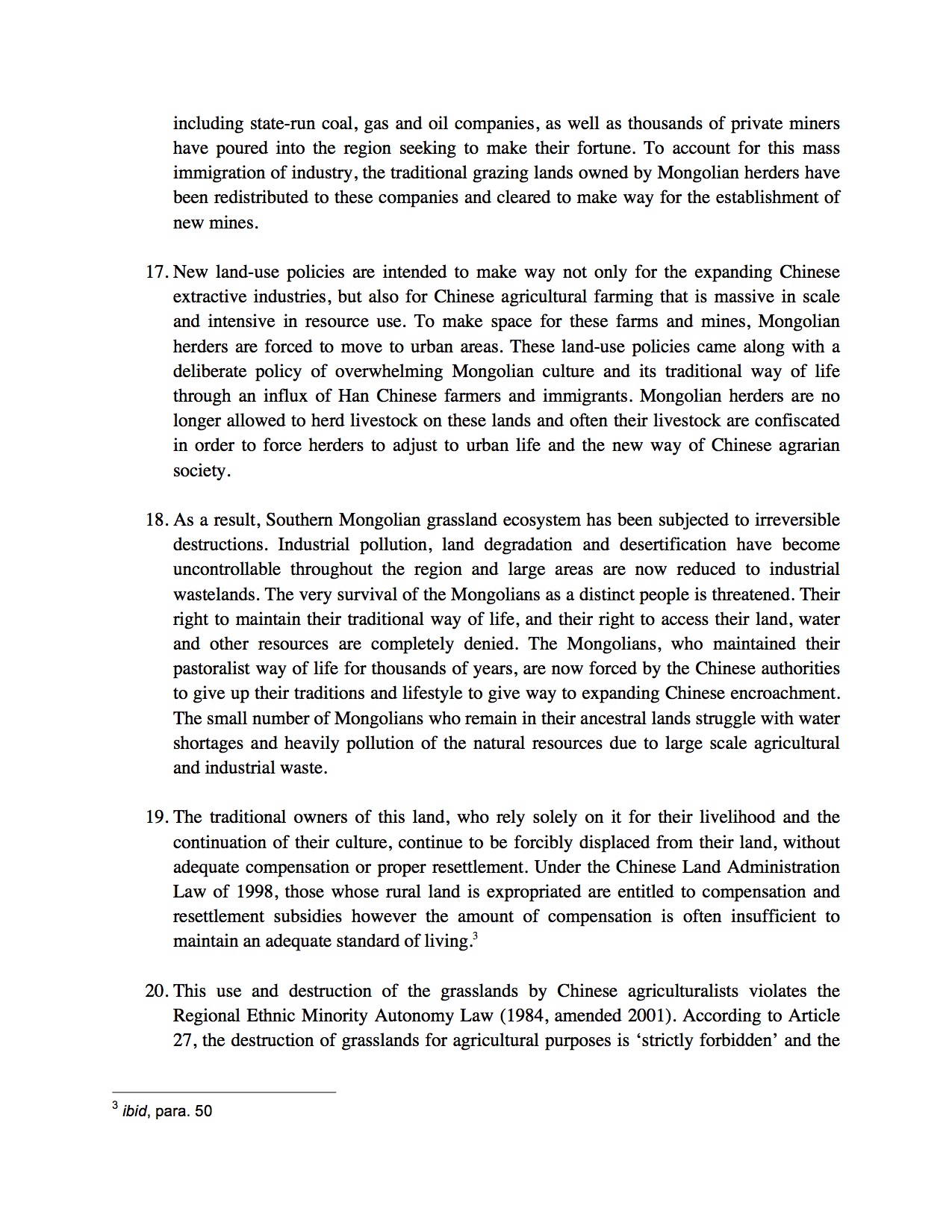
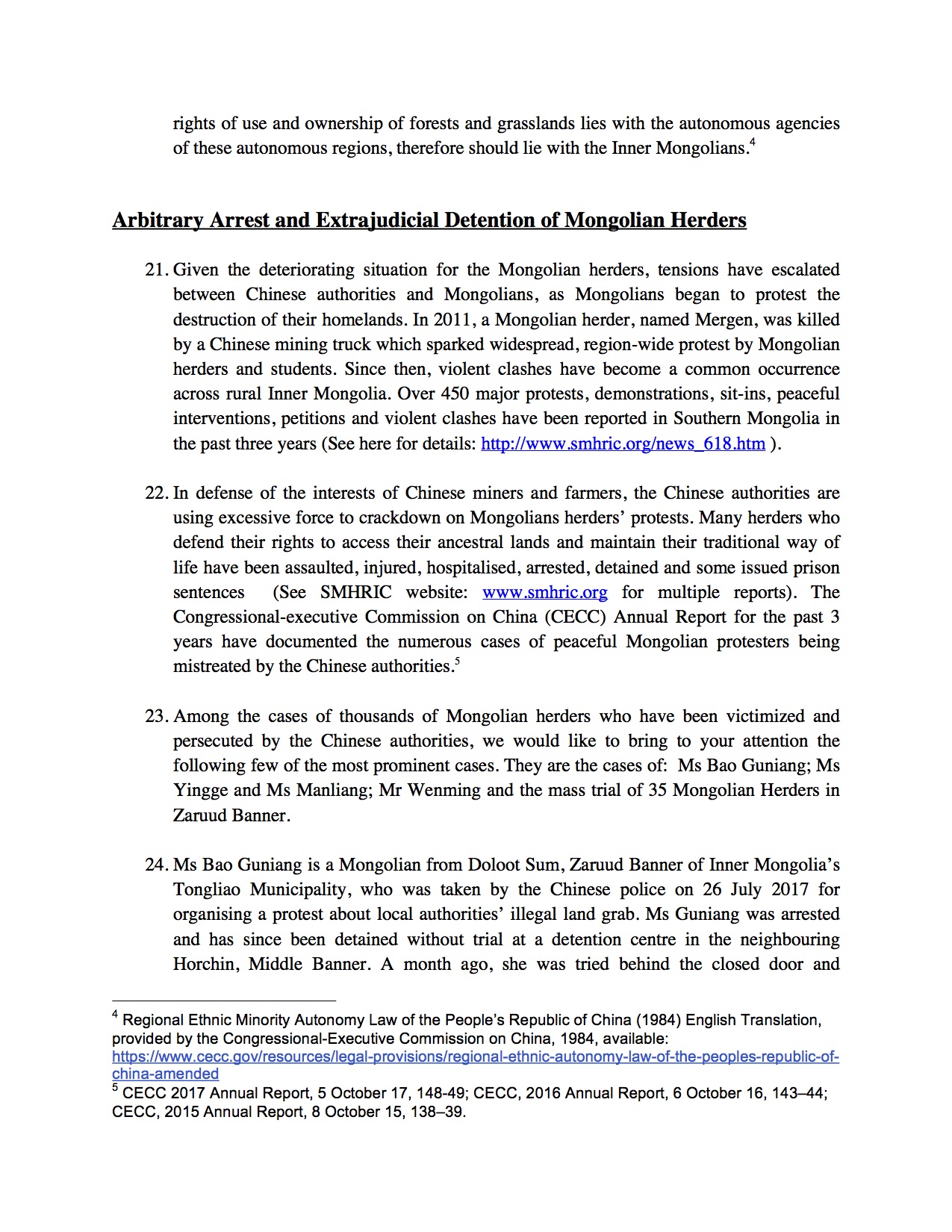
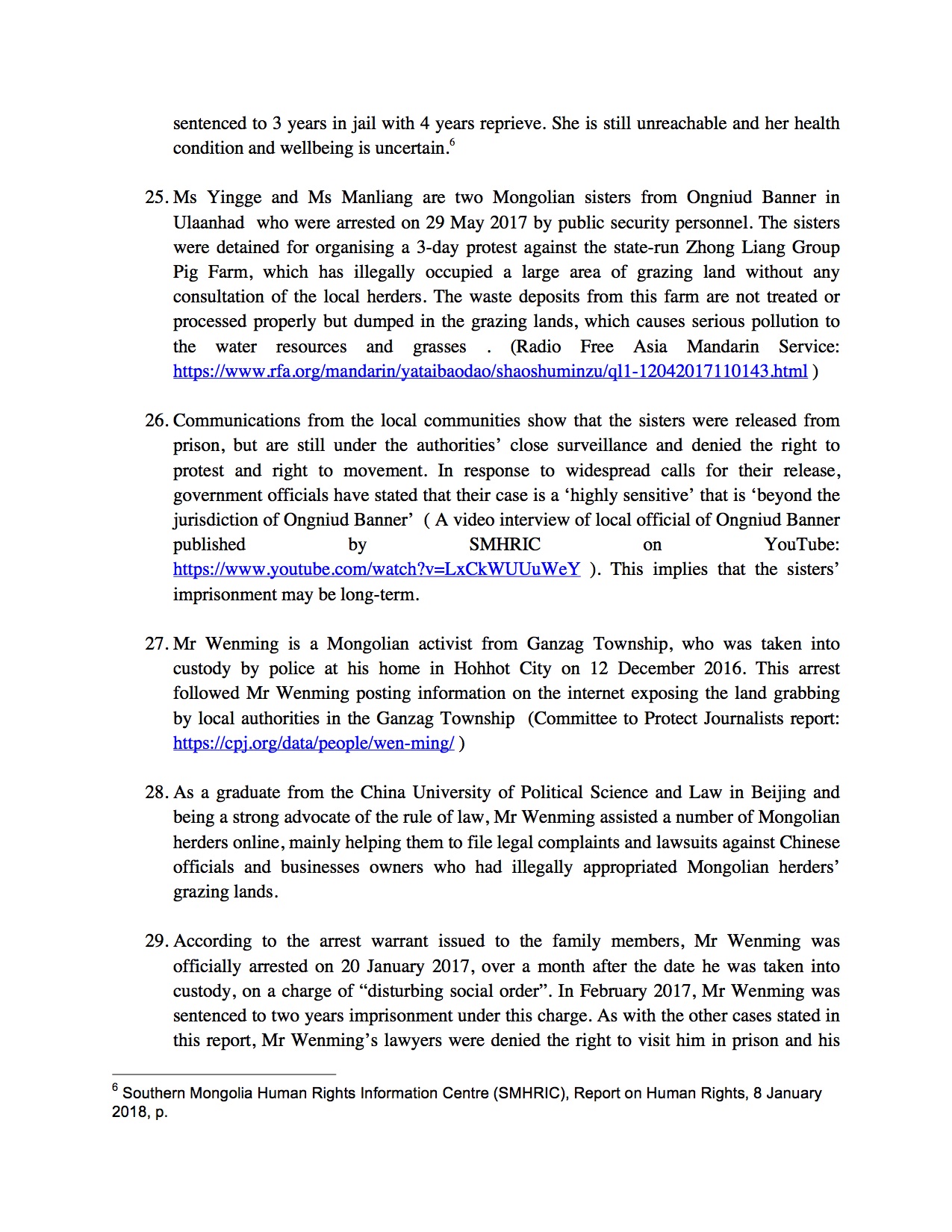
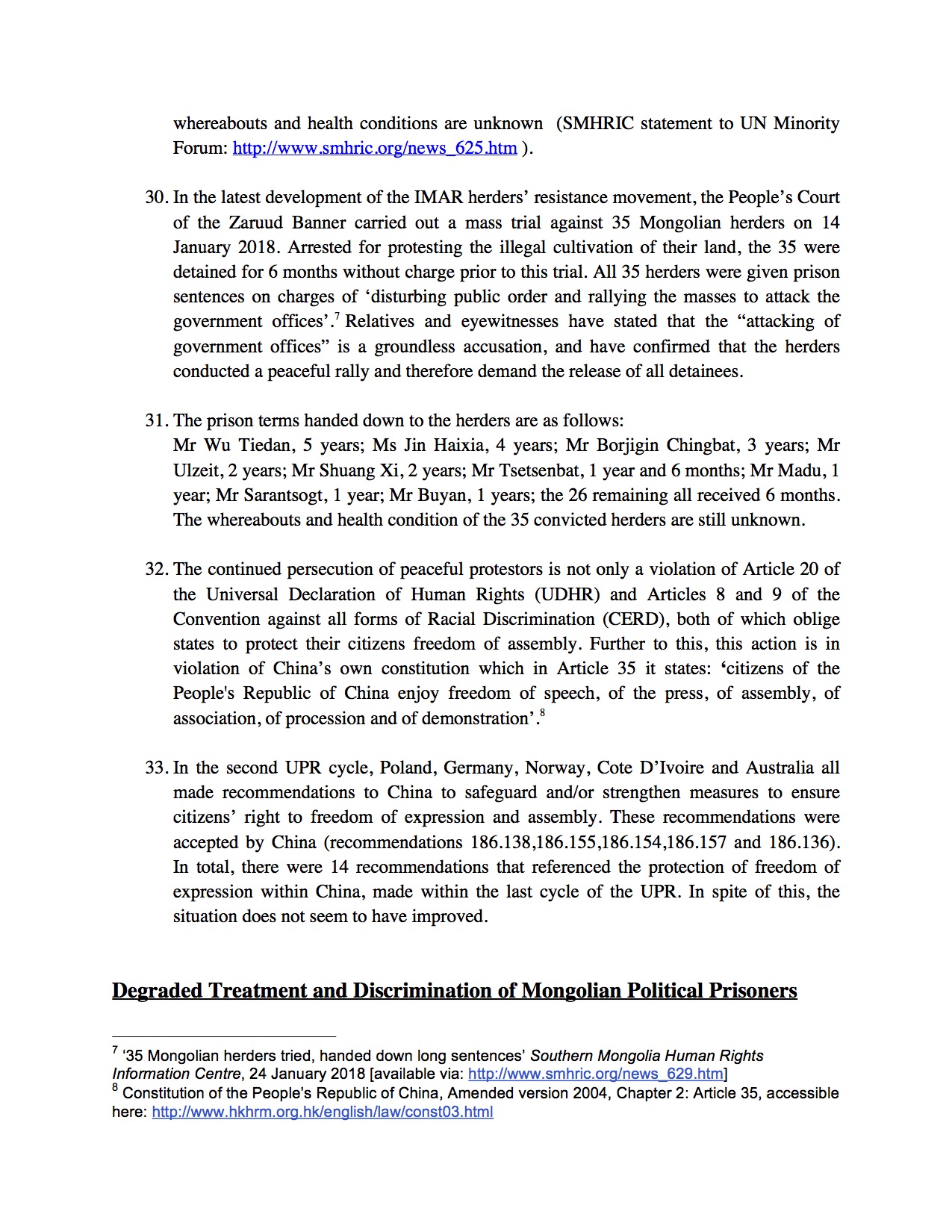
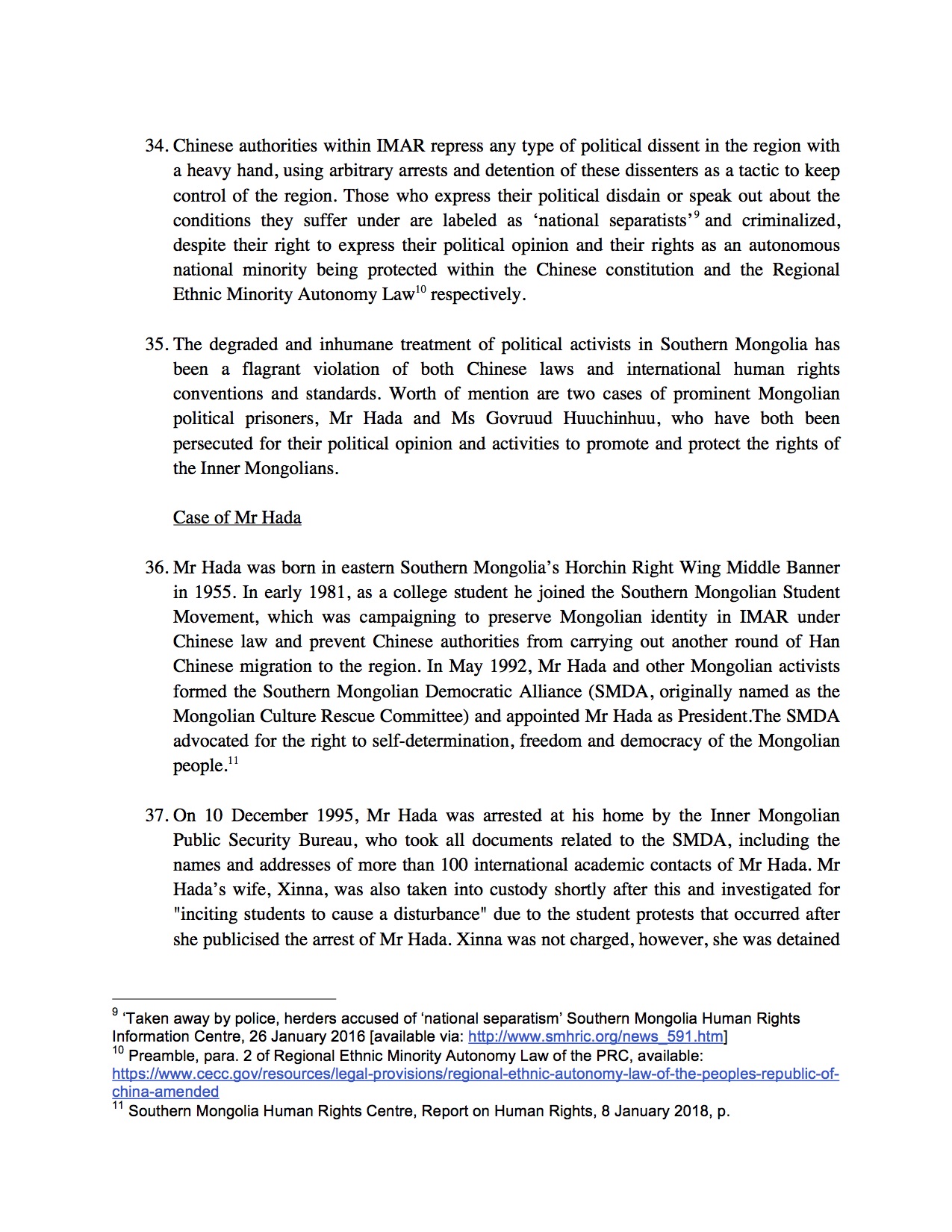

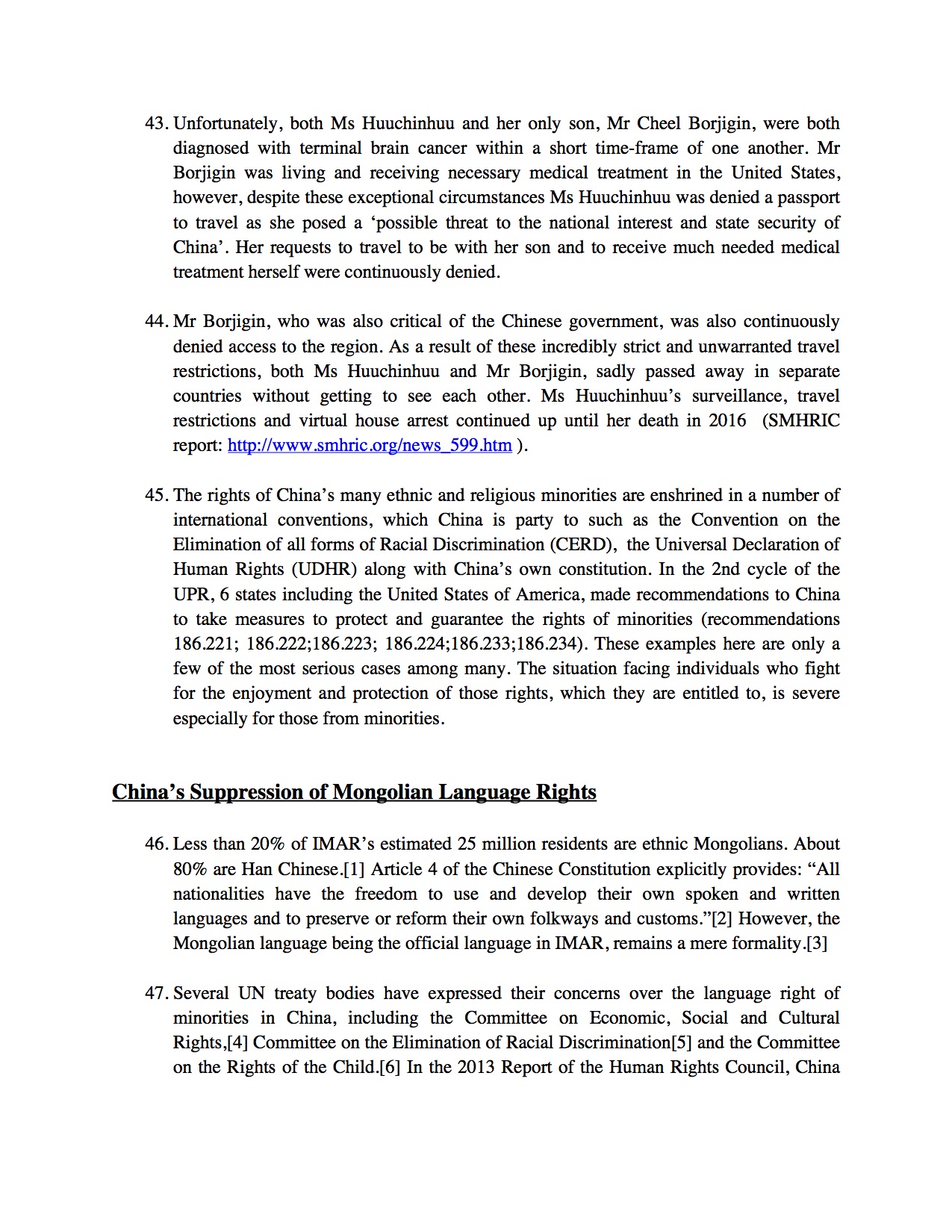
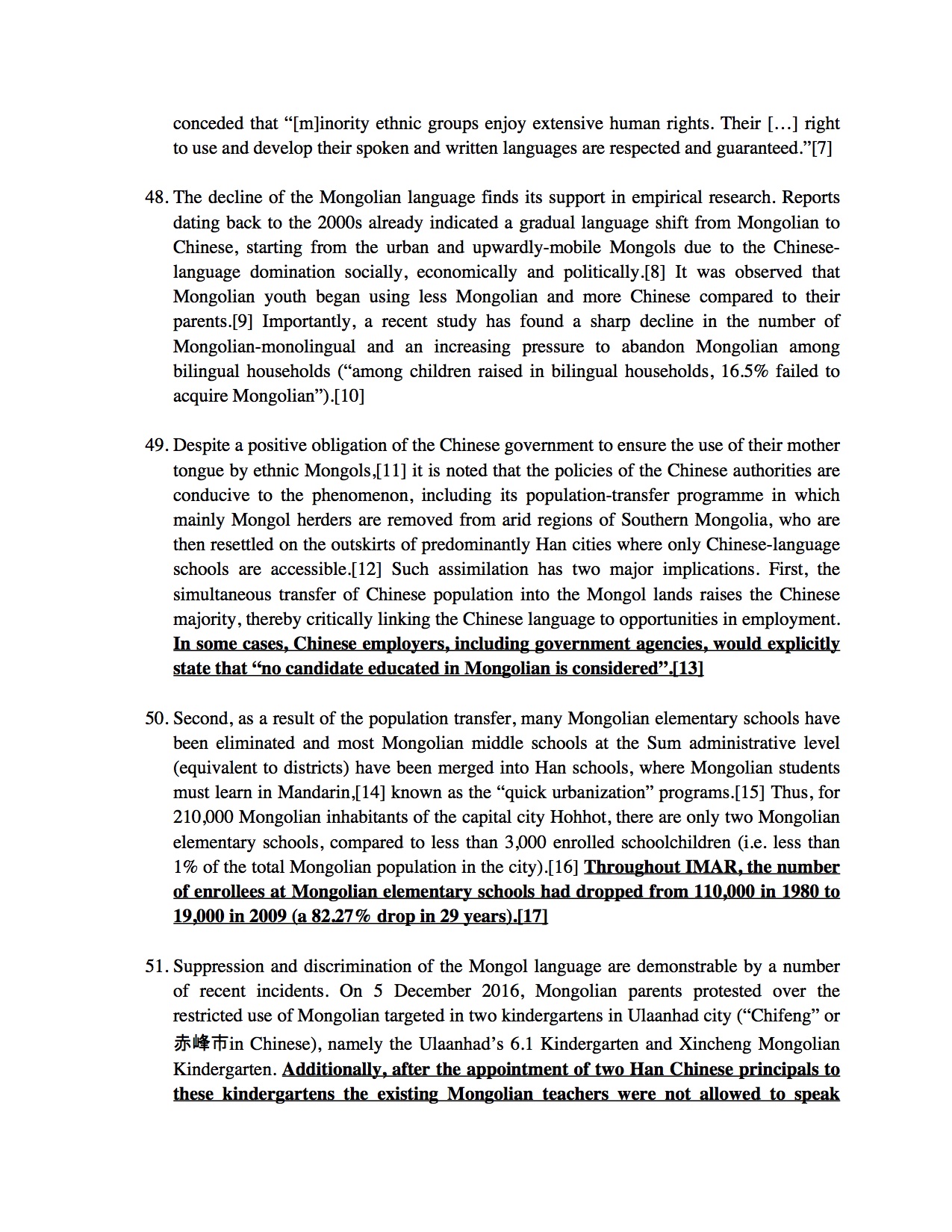
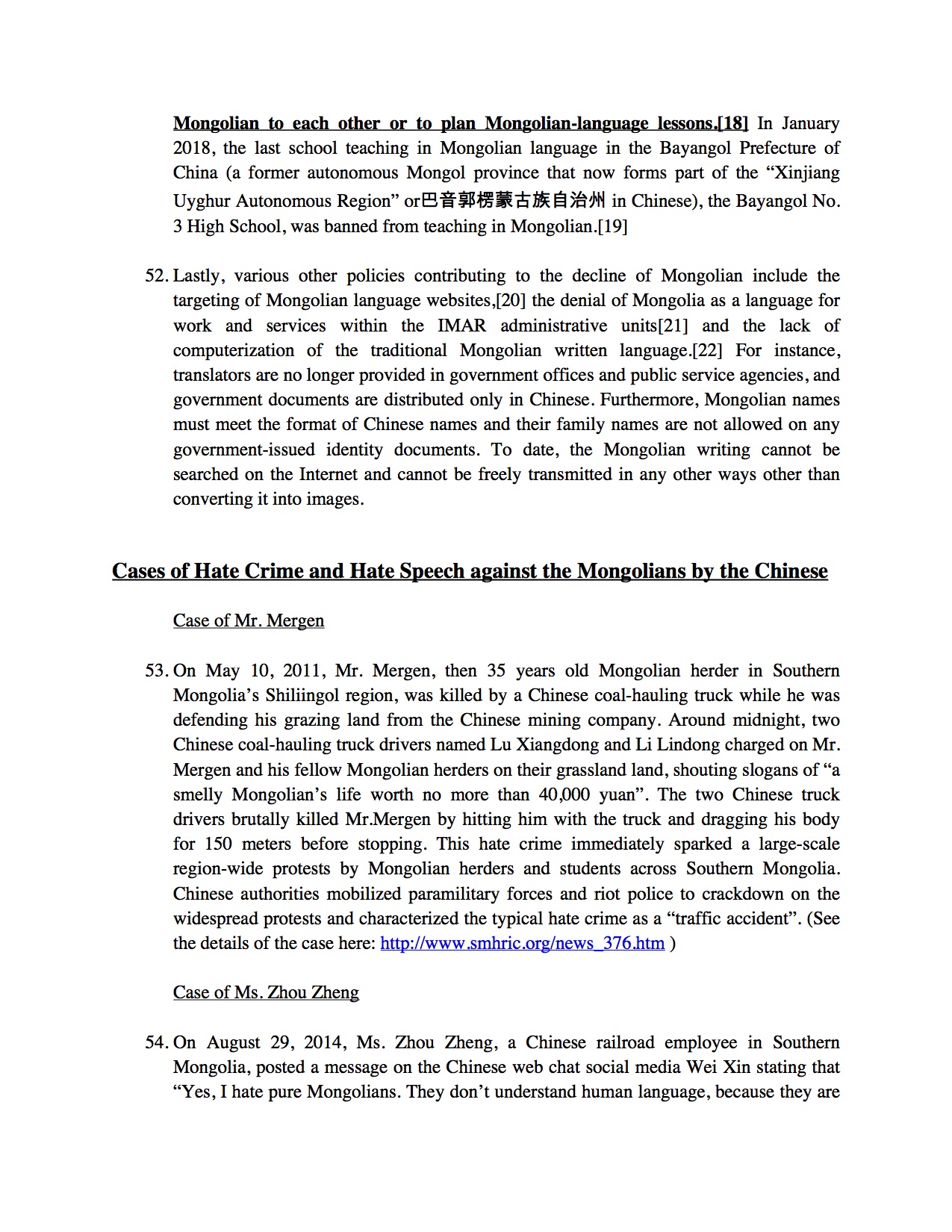
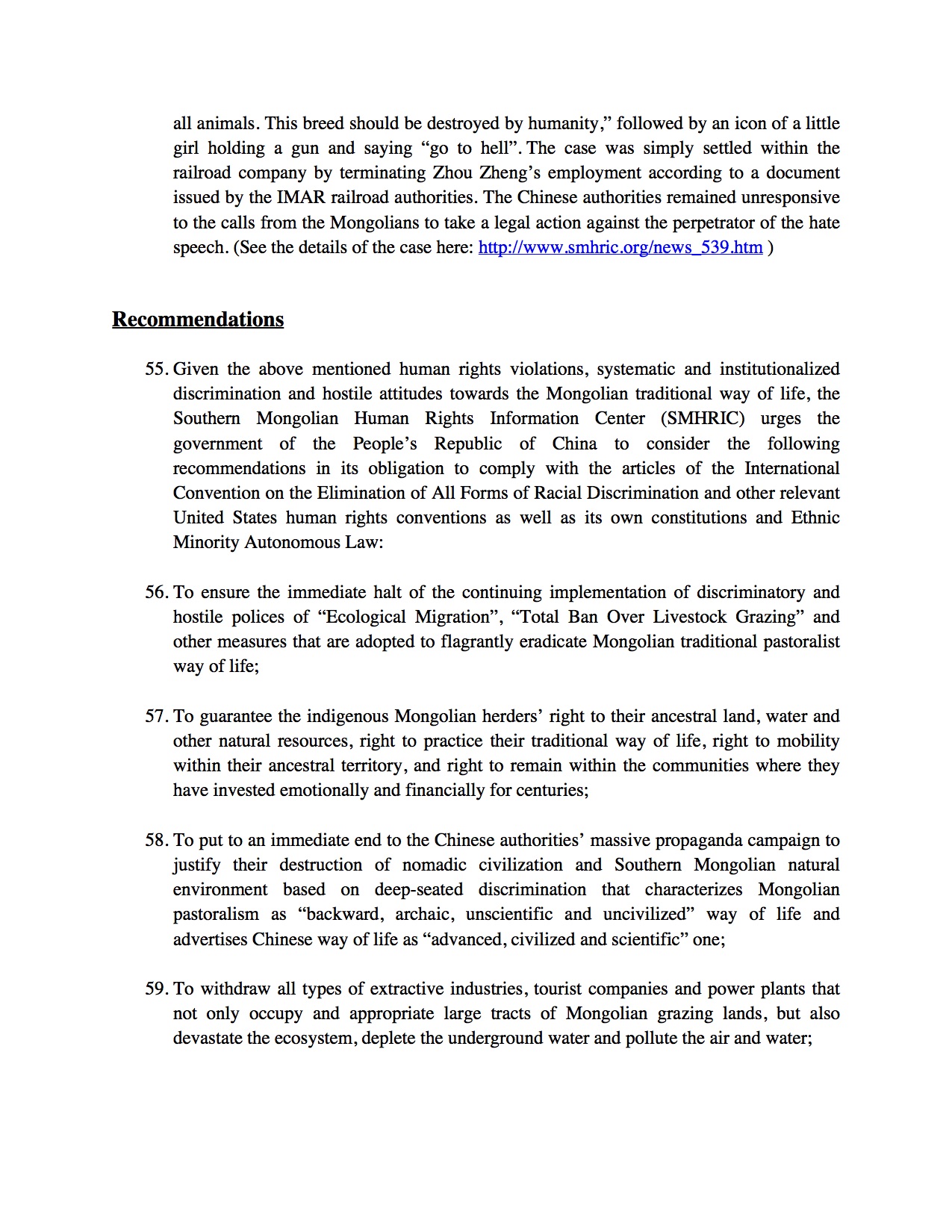
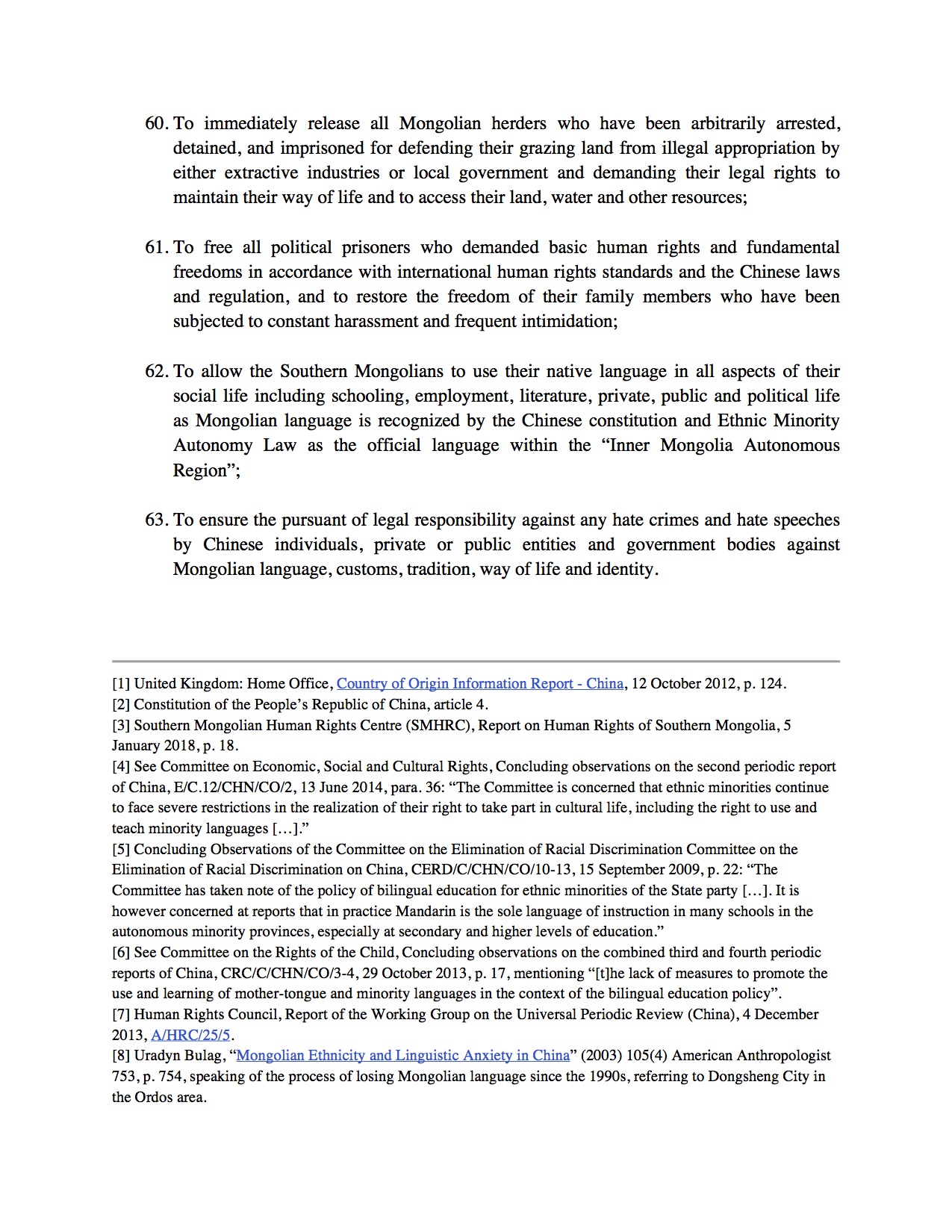






 Beyond
Great Walls: Environment, Identity, and Development on the Chinese
Grasslands of Inner Mongolia
Beyond
Great Walls: Environment, Identity, and Development on the Chinese
Grasslands of Inner Mongolia China's
Pastoral Region: Sheep and Wool, Minority Nationalities, Rangeland
Degradation and Sustainable Development
China's
Pastoral Region: Sheep and Wool, Minority Nationalities, Rangeland
Degradation and Sustainable Development The
Ordos Plateau of China: An Endangered Environment (Unu Studies on
Critical Environmental Regions)
The
Ordos Plateau of China: An Endangered Environment (Unu Studies on
Critical Environmental Regions)